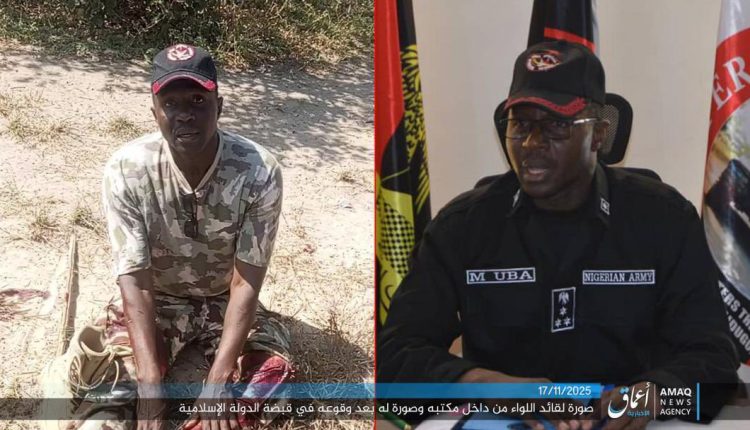UBA: ANOTHER NIGERIAN GENERAL FALLS TO ISWAP AMBUSH LEAVING UNANSWERED QUESTIONS
ANALYSIS: The death of Brigadier-General M. Uba: A tragedy wrapped in questions

The death of Brigadier-General Musa Uba 25 Task Force Brigade Commander, has once again exposed the dangerous, grinding reality of Nigeria’s counter-insurgency war, where bravery is common, sacrifice is routine, and tragedy often arrives without warning.
The tragic death of Gen. Uba has revived painful memories for the theatre, especially the death of Brigadier-General Dzarma Zirkushi, the 28 Task Force Brigade commander who fell to the same ISWAP ambush on November 13, 2021 while leading reinforcements to Askira-Uba. Both brigades shared the same border.
Four years apart, General Uba met the same fate in eerily similar circumstances. Two Brigade commanders walked into volatile axes and neither returned. Both were ambushed by the same ruthless enemy. And both died with their troops — Zirkushi alongside seven soldiers, Uba with 4 soldiers and two civilian JTF.
Born on 27 January 1978, Gen. Uba was commissioned into the Nigerian Army in 2001. He built a reputation as a calm, steady and fearless commander. Promoted to Brigadier General in October 2024. He was the type of officer who never allowed his rank to distance him from the men he commanded. Those who served with him said he saw leadership as responsibility, not privilege.
That sense of duty shaped his final decision. According to insider accounts, the General moved out on 15 Nov 2025 with only 28 soldiers barely the size of a platoon usually commanded by a lieutenant. Military insiders said such a movement fell far below the minimum protection required for a Brigade Commander. Yet, in the urgency of the moment, he chose to go. “The commander of a brigade is not expected to move without adequate protection, gun trucks, Anti Aircraft Guns, APCs, MRAPs and flank cover,” a military source said.
The corridor he entered were two notorious dense forests on either side. It’s a known ISWAP crossing route. In the area, a blown bridge forces movement onto footpaths and motorcycles. Insiders say the late general crossed the destroyed routes on a motorcycle, a journey no brigade commander should ever have had to take. But this is the reality of the war commanders sometimes move like junior officers because terrain, urgency and limited assets give them no other options.
When the ambush struck, it was sudden and violent. Insiders say General Uba survived the initial contact long enough to take cover. In a desperate but composed moment, he established communication with the Theater Command through a WhatsApp video call. He confirmed he was alive and transmitted his location. That call triggered a rapid rescue operation involving ground troops and air support, and for a moment, there was hope.
His messages during those tense minutes captured a man determined to hold on until help arrived. What followed has raised troubling questions. Within hours of the proof-of-life call, the video and details circulated widely across military networks and social media. Military experts familiar with the operation insist that ISWAP does not possess the capability to track WhatsApp locations, which has led to uncomfortable speculation. Some believe the terrorists may have captured him earlier and allowed the call to lure more troops. Others suspect the coordinates leaked through carelessness or betrayal after they spread beyond the immediate command chain. Another possibility is that once social media posts confirmed his survival, insurgents moved quickly into the area to intercept him.
A security source familiar with the rescue mission said the Theatre Commander pushed forward to rescue the general, but by the time troops secured the location, the General was no longer there. The similarities between his death and Zirkushi’s are too stark to ignore: both men moved under uncertain intelligence; both stepped into extremely hostile axes; both were ambushed; and both died doing what officers are sworn to do.
Their deaths reflect a deeper truth about the war in the Northeast. Nigerian troops operate in some of the most dangerous, complex terrain imaginable, facing enemies who have evolved into highly adaptive, intelligence-driven networks. These insurgents know the terrain better than anyone; they have informants in villages, spotters on hills, collaborators on roads. They intercept movements, map patrol routes, study routines and exploit every vulnerability. Against this, soldiers often work with limited equipment, insufficient assets and strained logistics yet they continue to march, patrol, reinforce and hold ground every day.
It is easy for the public to forget the weight of what these men carry, but their sacrifices tell the story clearly. This is the cost of a war that has dragged on for over a decade. This is what the military confronts daily; dangerous missions, flawed intelligence, shifting threats, and the constant possibility that doing the right thing may come at the highest price.
Brigadier General Mohammed Uba died in uniform, under the harsh Borno climate, trying to secure our country. His death is more than a battlefield loss. It is a national failure, a painful reminder that bravery alone cannot compensate for systemic weaknesses. Nigeria mourns him, just as it mourned Zirkushi. But mourning is not enough. To honour their sacrifice, the country must confront the hard questions their deaths leave behind and ensure no commander walks into another avoidable ambush.


